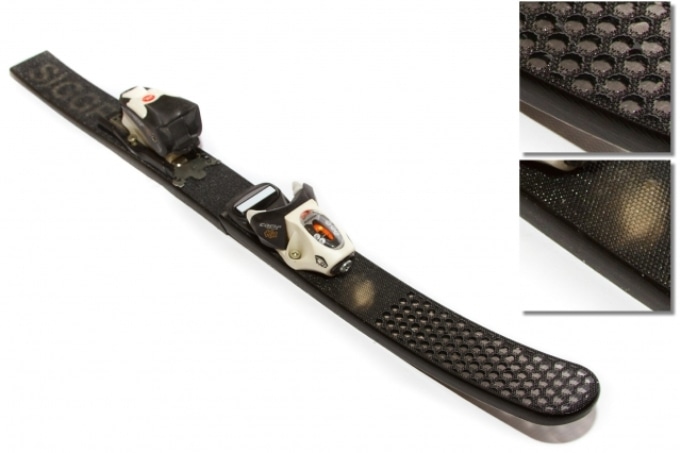Oct 12 2016
 To demonstrate Foundry, MIT researchers designed and fabricated skis with retro-reflective surfaces, a ping-pong paddle, a helmet, and even a bone that may someday be used for surgical planning. (Image: Kiril Vidimce/MIT CSAIL)
To demonstrate Foundry, MIT researchers designed and fabricated skis with retro-reflective surfaces, a ping-pong paddle, a helmet, and even a bone that may someday be used for surgical planning. (Image: Kiril Vidimce/MIT CSAIL)
3D printing technology has developed over the past decade to include multi-material fabrication, facilitating manufacture of powerful, functional objects. Although several advances have been made, it is still difficult for non-programmers to produce objects comprising of several materials or material blends without an interface that is more user-friendly.
Researchers from MIT's Computer Science and Artificial Intelligence Laboratory (CSAIL) are set to launch “Foundry,” a system capable of custom-designing numerous 3D printed objects with many materials.
In traditional manufacturing, objects made of different materials are manufactured via separate processes and then assembled with an adhesive or another binding process. Even existing multi-material 3D printers have a similar workflow: parts are designed in traditional CAD [computer-aided-design] systems one at a time and then the print software allows the user to assign a single material to each part.
Kiril Vidimče, PhD Student, MIT
On the contrary, users will be able to use Foundry to vary the material properties at a very fine resolution. This was not possible before.
“It’s like Photoshop for 3D materials, allowing you to design objects made of new composite materials that have the optimal mechanical, thermal, and conductive properties that you need for a given task,” says Vidimče. “You are only constrained by your creativity and your ideas on how to combine materials in novel ways.”
To illustrate their point, the team designed and fabricated a helmet, skis with retro-reflective surfaces, a tricycle wheel, a ping-pong paddle, and a bone that could one day be used for surgical planning.
Redesigning multi-material objects using present day design tools would take skilled engineers several days and some designs would be completely impractical. However with Foundry, users can produce these designs within minutes.
3D printing is about more than just clicking a button and seeing the product. It’s about printing things that can’t currently be made with traditional manufacturing.
Kiril Vidimče, PhD Student, MIT
The research paper’s co-authors include MIT Professor Wojciech Matusik and students from his Computational Fabrication Group: PhD student Alexandre Kaspar and former graduate student Ye Wang. The paper is to be presented at the Association for Computing Machinery’s User Interface Software and Technology Symposium (UIST) in Tokyo.
How it Works
A lot of currently available multi-material 3D printers are used for prototyping, because the materials presently used are not very functional. Users normally make preliminary models, make quick modifications, and then print them again. New platforms, such as MIT’s MultiFab are working to develop highly functional materials suitable for volume manufacturing.
For now, Foundry acts as the interface to assist in the creation of such objects. To use it, users will have to first design the object in a conventional CAD package such as SolidWorks. When the file is exported, the object’s composition can be established by developing an “operator graph” that can include any of roughly 100 fine-tuned actions known as “operators.”
Operators will be able to “remap,” “subdivide,” or “assign” materials. While some operators can smoothly split an object into two or more different materials, others can provide a more gradual shift from one material to another.
Foundry allows users to mix and match any mixture of materials and also allot precise properties to different parts of the object, integrating operators together to create new ones.
For instance, to create a cube possessing both rigidity and elasticity users would have to assign a “rigid operator” to ensure that one part is rigid, and an “elastomer operator” to make the other part elastic; a third “gradient operator” would be required to link the two and introduce a gradual transition between materials.
The designs can be previewed in real-time, so users will no longer have to wait till the final steps in the printing process to view the whole design.
Testing the System
Foundry was first tested on non-designers by the team. The challenge was to create a teddy bear, an integrated “tweel” (tire and wheel), and a bone structure in an average of 26, 48, and 56 minutes respectively. The non-designers were briefed for just an hour.
Additionally the team also designed a custom wheel for a toddler tricycle. The wheel had an optimized structure to enhance lateral strength, and a foam outer wheel for better suspension.
Several practical applications in medicine and more may be possible using Foundry to exploit the maximum capabilities of the 3D printing platform. Surgeons could produce excellent quality replicas of objects such as bones to practice on, while doctors could produce dentures with better comfort and other products that would benefit from having both rigid and soft parts.
Vidimče hopes that Foundry would create a community of designers who can share new operators with each other to widen the possibilities of what can be manufactured. He also wishes to incorporate Foundry into the workflow of CAD systems existing today.
The user should be able to iterate on the material composition in a similar manner to how they iterate on the geometry of the part being designed. Integrating physics simulations to predict the behavior of the part will allow rapid iteration on the final design.
Kiril Vidimče, PhD Student, MIT
The National Science Foundation supported the research.
Designing for 3-D Printing
MITCSAIL/Youtube.com